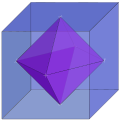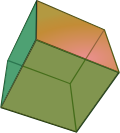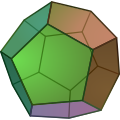Polyhedron

A polyhedron (polyhedra or polyhedrons if more than one) is a geometrical shape. It is a 3D shape with flat faces, and straight edges. Each face is a polygon surrounded by edges. Usually it is known by the number of faces, corners, or edges it has.
There are many groups of polyhedra, which can either be only a small set, or can be infinite. Prisms, pyramids, antiprisms, and bipyramids are groups of polyhedra.
A regular polyhedron has faces that are all the same, corners that are all the same, and edges that are all the same. A uniform polyhedron can have one or two kinds of its parts be all the same.
Definition
Two types of polyhedron are convex and concave. The edge connecting any two points of a convex polyhedron is inside the polyhedron. The line connecting two points of a concave polyhedron may go outside the polyhedron. The Platonic solids are regular convex polyhedra.
Mathematicians do not always agree on what makes a polyhedron. Some may only consider the convex polyhedra, and disregard the ones that are not convex. Some polyhedra are degenerate, meaning that when drawn as real objects, they look flat.
Naming
Usually, polyhedra are named by the number of faces they have. The first polyhedra are the tetrahedron, which is made of four triangles, pentahedron (five faces, can look like a four-sided pyramid), hexahedron (six faces, a cube if it is regular), heptahedron (seven faces) and octahedron (eight faces). Prisms, pyramids and other shapes can also be named after how many faces they have.
Polyhedron Media
The midsphere of a polyhedron. The red circles indicate the points at which a cone, with its apex at a vertex, is tangent to the sphere. Rendered in POV-ray based on a different rendering of the same model from D. Eppstein (2005), Quasiconvex programming, Combinatorial and Computational Geometry, Goodman, Pach, and Welzl, eds., MSRI Publications 52, 2005, pp. 287-331, arXiv:cs.CG/0412046.
Some polyhedra rotating around a symmetrical axis (at Matemateca IME-USP)
Full icosahedral symmetry divides the sphere into 120 triangular domains.
Other websites
- Eric W. Weisstein, Polyhedron at MathWorld.
- Making Polyhedra
- Polyhedra Pages
- Stella: Polyhedron Navigator – Software for exploring polyhedra and printing nets for their physical construction. Includes uniform polyhedra, stellations, compounds, Johnson solids, etc.
- The Uniform Polyhedra
- Virtual Reality Polyhedra – The Encyclopedia of Polyhedra
- Paper Models of Polyhedra Many links
- Paper Models of Uniform (and other) Polyhedra
- Interactive 3D polyhedra in Java Archived 2005-04-03 at the Wayback Machine
- World of Polyhedra Archived 2006-04-14 at the Wayback Machine – Comprehensive polyhedra in flash applet, showing vertices and edges (but not shaded faces)
- Polyhedra software, die-cast models, and posters
- Electronic Geometry Models – Contains a peer reviewed selection of polyhedra with unusual properties
- Symmetry, Crystals and Polyhedra Archived 2017-02-24 at the Wayback Machine
- uniform solution for uniform polyhedra by Dr. Zvi Har'El Archived 2011-05-20 at the Wayback Machine
- Java applet with the use of kaleido Archived 2007-08-18 at the Wayback Machine
- Origami Polyhedra – Models made with Modular Origami
- Polyhedra Collection[dead link] – Various virtual and physical polyhedra models















